 |
 |
|
Updated: 27th June It was revealed today (16th June) that the suspicions that many within the community and the building industry have had over the appalling fire which gutted the Grenfell Tower block in the richest borough in the country, killing an estimated 150 people; was facilitated by the use of a cheap and unsuitable version of the outer cladding of the concrete building. Indeed, it has in the last few days, been found to also have been illegal to use the specific type of cladding used on the Tower to cover the whole of the outside of the building! Whilst the wider media are playing down the number of deaths, and stating that the latest confirmed deaths is 30, the local community are angry because they estimate that around 150 people have been killed, when you consider the great number of missing residents there are from the Tower building.
Rather than use the appropriate fire resistant cladding that would have provided a 2 hour period during which the fire brigade would have attended and put out the fire, and which would have stopped the fire from engulfing the entire building as it did in 30 minutes; the private company decided to cut corners on cost and installed cladding which was just £2 per square meter cheaper! This gave them an overall saving of some £5000 which could have bought them three mac book laptop computers! The cladding is designed to ensure weathering of the building does not take place as it would do if there was no covering of the concrete fascia of the building. It comprises of an outer sheet of aluminium with a hard mineral backing, bonded together and highly fire resistant. Installed behind each panel of this cladding is a thick layer of insulation material which is also supposed to be fire-resistant.
Omnis Exteriors, manufactures the ACM cladding at a workshop in St Helens and has supplied dozens of building projects around the country, where they have been used on Tower Blocks similar to that of Grenfell Tower. In addition to the cheap and nasty material being used instead of the appropriate cladding, the Fire legislation and building regulations has been watered down by the Tories in 1986 and latterly by the Labour government in 2005. However, as reported in today's Guardian newspaper, in Germany construction companies have been banned from using plastic-filled cladding, such as Reynobond PE, on towers more than 22 metres high since the 1980s when regulations were brought in to improve fire safety at residential blocks. Whereas in the UK, regulations were weakened and watered down by Thatcher's Tory government! The Guardian report goes further: Germany is deemed to have some of the most stringent fire regulations in the world. High-rise tower blocks are common, particularly in former communist parts of the country, where they dominated new-build housing for decades. Quoting Berlin’s fire chief, Wilfried Gräfling, as saying "the London fire made it clear that fire regulations should be tightened further with only mineral materials used in cladding panels." "We will try to persuade lawmakers that flammable material should no longer be allowed to be used as an insulant. Only mineral material that can’t burn, ensuring that it’s no longer possible for a fire to spread via the cladding.” he told Der Spiegel. In London massive privatisation and cuts to the Fire Brigade in terms of both staffing levels and equipment along with the introduction of private landlords and associations being given the responsibility of fire prevention risk assessments and fire checks of their buildings rather than the Fire Brigade; has given rise to private landlords cutting corners in the standards of their properties and lack of adherence to safety legislation and fire prevention. But what is so shocking, but then again, not surprising, is that Kensington and Chelsea, the richest borough of London which is one of the richest cities in the world; the attitude towards the local authority member, Emma Dent Coad (now the area's Labour MP) when she was a Labour counselor; on raising the safety concerns of the residents of the high rise block in question, told her that millions had been spent on renovating the blocks and that the people living there should in fact be grateful and not complaining. She was visibly angry when telling that to Channel 4 News' Jon Snow on Wednesday this week. Worse still, the residents association had raised so many concerns about the lack of fire prevention and fire warning equipment in the flats along with only one fire escape for the whole of the building; that they had publicly stated that an incident of a fire breaking out, could cause massive loss of life and was just waiting to happen. All of their concerns have been ignored by Kensington and Chelsea Tenant Management Organisation (KCTMO) that maintains and runs the Tower blocks in the area and owned by local authority of Kensington and Chelsea.
“We have a very rich council which spent £26m repaving Exhibition Road for tourists at the same time as it was closing nurseries, pruning youth clubs, closing older people’s lunch clubs, not investing in social care. I found that absolutely sickening. We have very large reserves, of around £300m.” She is also frustrated at the council’s poor record of listening to tenants’ concerns. “This fire was entirely preventable if they had listened to the people living in the building who had countless times demanded the Tenant Management Organisation and the council address the issues they were concerned about. They wrote to the council countless times. They have to listen to people.” Sadly this shows once again that the government's 'Red Tape' attitude towards health and safety law and the shredding of 80% of it since 2010, is partly responsible for the attitude of private landlords and building management companies, as well as local authorities, many of whom are providing sub-standard accommodation and breaking what little health and safety law is left that they should abide with. Furthermore, and perhaps more importantly, local authorities have slashed their environmental departments and officers following the cuts to their income from the Government; resulting in the lack of pro-active examinations of properties and businesses. Further proof of the callous attitude of the Tories can be seen by the fact that a fire in 2009 which killed 6 people in Lakanal House The housing minister, Gavin Barwell, who lost his seat in last week’s general election did not instigate most of the findings and recommendations made following the investigation of that incident. He also delayed a report into living in high rise apartments in the UK and fire safety. He is now the prime minister’s chief of staff. There are no regulations requiring the use of fire-retardant material in cladding used on the exterior of tower blocks and schools. But, for many years the Fire Protection Association (FPA) has been lobbying the government to make it a statutory requirement for local authorities and companies to use only fire-retardant material. But it fell on deaf ears which is no surprise considering the Tories hate any form of legislation involved with health and safety as they claim it is an unnecessary burden on business.
In fact there was no working fire alarms in the building and none in the community areas, with there being only one way of exiting, down the main stairwell. There was no sprinkler system in the building which would have undoubtedly save many lives, and tenants notices instructed them to remain in their flats if a fire broke out. Whilst internal construction is supposed to act as a firewall to ensure occupants are safe for the period of time required for the fire brigade to attend and assess the level of fire and put it out. Now that a public enquiry has been announced and even before then the residents have been calling for those responsible for the decisions to ignore their concerns over a fire and what it would do to the lives and property of the people living in Grenfell Tower, to be made responsible and named. Amidst the inaction of the government, the media have finally started to point out that the policies of austerity may well have contributed to the circumstances under which a foretold horror of blaze taking hold of a high rise housing hundreds of residents, could actually occur. With the lack of morality amongst private landlords and building companies, requiring laws in order for them to apply common sense and a concern for the health and safety of their residents; now being in the public eye, the comparisons within the richest borough in the country of how the local council treats it's poorer residents compared to its richest, could not be more illustrated by the policies of Kensington and Chelsea local authority of ethnically cleansing their borough of poor people and those from ethnic minorities by moving them out of the borough completely; even to distant places such as Plymouth. This policy say the local people has been going on for years. Even today (17th June), it is clear that the borough wishes to re-house the tenants of Grenfell Tower outside of the borough, according to media reports and the lack of assurances coming from Theresa May on this front. Meanwhile Jeremy Corbyn has not only visited the people affected by this atrocious fire, as early as Tuesday morning, he has written to Theresa May outlining actions he says she must take. With Channel 4 News journalist Cathy Newman demanding the answer to the question, "Can those living in the 4,000 high rises across the country go to bed tonight knowing they are safe?" from Works and Pensions Secretary David Gauke MP, and getting no answer; it is quite evident that there is a risk across the country to those living in high rises that similar flammable cladding to that used on Grenfell Tower has been used elsewhere, and on a majority of the high rises in the country. This has now been borne out as a result of continuing tests on the countries estimated 4,000 residential tower blocks which is showing that these illegal cladding installations have been used and are failing the tests being conducted by local authorities that have tested their properties so far! This shows an endemic failure by local authorities and 'responsible persons' as determined by the Regulatory Reform (Fire Safety) Order 2005 (RRO); to carry out their legal responsibilities! Para 18 of their interim report states: The principal means of regulation and control for residential property, including high rise blocks, are the Housing Acts 1985 and 2004. These Acts make housing authorities specifically responsible for keeping the condition of all housing in their area, including their own housing stock, under review and for checking all aspects of health and safety, including fire safety.
But the situation is that responsibilities for the prevention of fire and for the safety of occupants of premises is widely spread and does not lie within the control of the Fire Brigade alone. A footnote (5) adds: The building regulations have some requirement for sprinklers in certain building types. Officers recommend that this should be extended to include more building types specifically where vulnerable people are likely to occupy such as schools, care homes and high rise residential premises. Paras 22 to 24 of the London Fire Brigade report to its committee meeting of September 2013 states: 22. Local authorities are responsible for keeping the condition of all housing in their area, including their own housing stock, under review and for checking all aspects of health and safety, including fire safety.
The companies involved in the refurbishment and in charge of the project were: Harley Facades - Confirmed it had installed the panels bought from Omnis in the work it performed on Grenfell Tower. Omnis had sold the ACM cladding to Harley Facades, which was responsible for installing it. Grenfell Tower is owned by the local council of the Royal Borough of Kensington and Chelsea and maintained by Kensington and Chelsea Tenant Management Organisation (KCTMO) The whole question of private landlords and housing association and management companies and the UK's building regulations along with the massive depletion of Fire brigade resources, is now in the spotlight like never before. Download the London Fire And Emergency Planning Committee minutes and report here Source: The Guardian / Grenfell Action Group / London Fire Brigade / London Fire And Emergency Planning Committee |
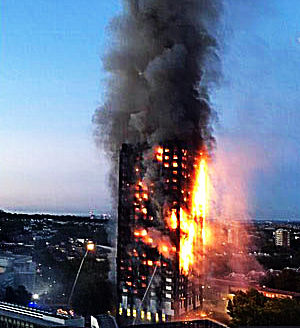 The spread of the fire at such a rapid speed, taking only 30 minutes to engulf the whole of the building, has placed immediate suspicions on the the aluminium composite material (ACM) cladding installed over the concrete fascia of the building.
The spread of the fire at such a rapid speed, taking only 30 minutes to engulf the whole of the building, has placed immediate suspicions on the the aluminium composite material (ACM) cladding installed over the concrete fascia of the building. 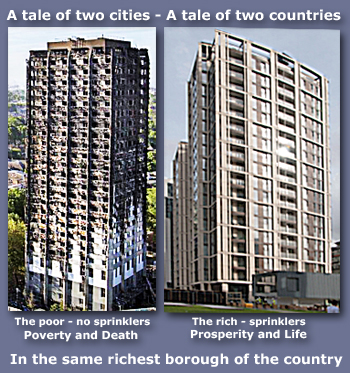 The issue over the cladding used is quite simple - there are two varieties: one is made of plastic backing on an aluminium front that is outward facing to prevent weather damage to the fascia of the building and stop egress of rain water into the concrete; and the other has a mineral backing which is inflammable as is the aluminium unless the heat applied directly to it is over 600 degrees centigrade.
The issue over the cladding used is quite simple - there are two varieties: one is made of plastic backing on an aluminium front that is outward facing to prevent weather damage to the fascia of the building and stop egress of rain water into the concrete; and the other has a mineral backing which is inflammable as is the aluminium unless the heat applied directly to it is over 600 degrees centigrade.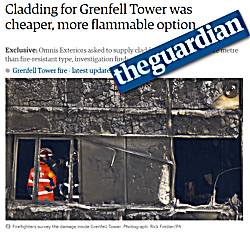 Frankfurt’s fire chief, Reinhard Ries, said he was appalled at the fire at Grenfell Tower and said tighter fire-safety rules for tower blocks in Germany meant that a similar incident could not happen there. US building codes also restrict the use of metal-composite panels without flame-retardant cores on buildings above 15 metres.
Frankfurt’s fire chief, Reinhard Ries, said he was appalled at the fire at Grenfell Tower and said tighter fire-safety rules for tower blocks in Germany meant that a similar incident could not happen there. US building codes also restrict the use of metal-composite panels without flame-retardant cores on buildings above 15 metres. Speaking to the Guardian newspaper yesterday she said:
Speaking to the Guardian newspaper yesterday she said: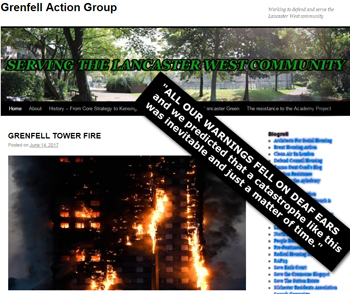

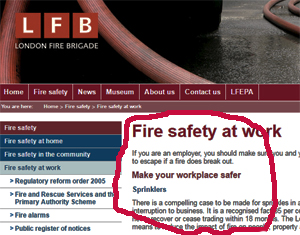 This makes it clear that the responsibility for fire safety and fire prevention, lies with the local authority and that in the case of Grenfell Tower; these responsibilities have NOT been undertaken min such a manner as to stop the use of illegal cladding on the outside of the building.
This makes it clear that the responsibility for fire safety and fire prevention, lies with the local authority and that in the case of Grenfell Tower; these responsibilities have NOT been undertaken min such a manner as to stop the use of illegal cladding on the outside of the building. 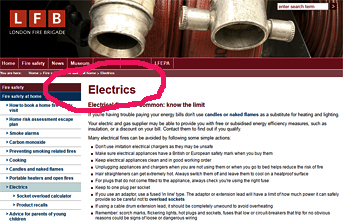 So, it is clear even at this early stage after the fire, that the question of corporate manslaughter of some 150 people is now being raised as the facts are being established of the courses of this worst fire since before the second world war to hit any residential property in the UK.
So, it is clear even at this early stage after the fire, that the question of corporate manslaughter of some 150 people is now being raised as the facts are being established of the courses of this worst fire since before the second world war to hit any residential property in the UK.